Industrial Master Bedroom
Industrial design is a decor theme that was born out of necessity and has remained popular due to its flexibility, workability, and proclivity for working with the elements and open spaces naturally included with the area in question.
Brought into being by the reclamation and reuse of industrial spaces, industrial design has progressed from a bare-bones way of life to a lifestyle celebrating individuality and creativity. Exposed pipes, bare walls, and lots of light are all things that industrial design is known for, but those are just a few of the aesthetics that you can incorporate to get the coveted industrial ambiance and appearance.
![51-Industrial-Bedroom-Ideas-[Picture-Inspiration-and-Tips]](https://homedecorbliss.com/wp-content/uploads/2019/12/51-Industrial-Bedroom-Ideas-Picture-Inspiration-and-Tips1-pin1.jpg)
Rather than just being about a few exposed pipes and wires, industrial design is actually about surprise, and unique decor is incorporated in extraordinary ways. Neutral colors help spaces seem bigger and let in more light, which gives you the room to do with your space exactly what you want, regardless of how odd or unexpected it is.
Let's go over a few of the ways that you can take a bedroom, and turn it into an industrially-themed haven. Watch the video for preliminary inspiration and continue reading the post.
1. Bricks and Baubles
Wide-open spaces and the fun bulbs around the headboard are prime decor choices when it comes to things that make this space a great example of industrial design. Throw in a fun rug and a few plants? You've got a personalized decor plan that is all about you!
2. Weathered Wood

While concrete is something commonly associated with industrial design concepts, it isn't essential to have it. Other "bare elements" like wood, wire, and brick can achieve the same effect, specifically if they're weathered.
3. Elements

All these exposed elements channel an industrial feel, making perfect use of the polished floor, concrete grey wall in the background, and the brick wall on the side. Keeping all the furniture metal and wood helped carry it home!
4. Impersonation

While the light grey color of concrete is often brought to mind when decorating after the model of industrialism, you may find the idea of concrete in your bedroom to be unappealing. You can replicate this effect, however, with wood or paint in the color of the concrete in question.
5. Mix and Match
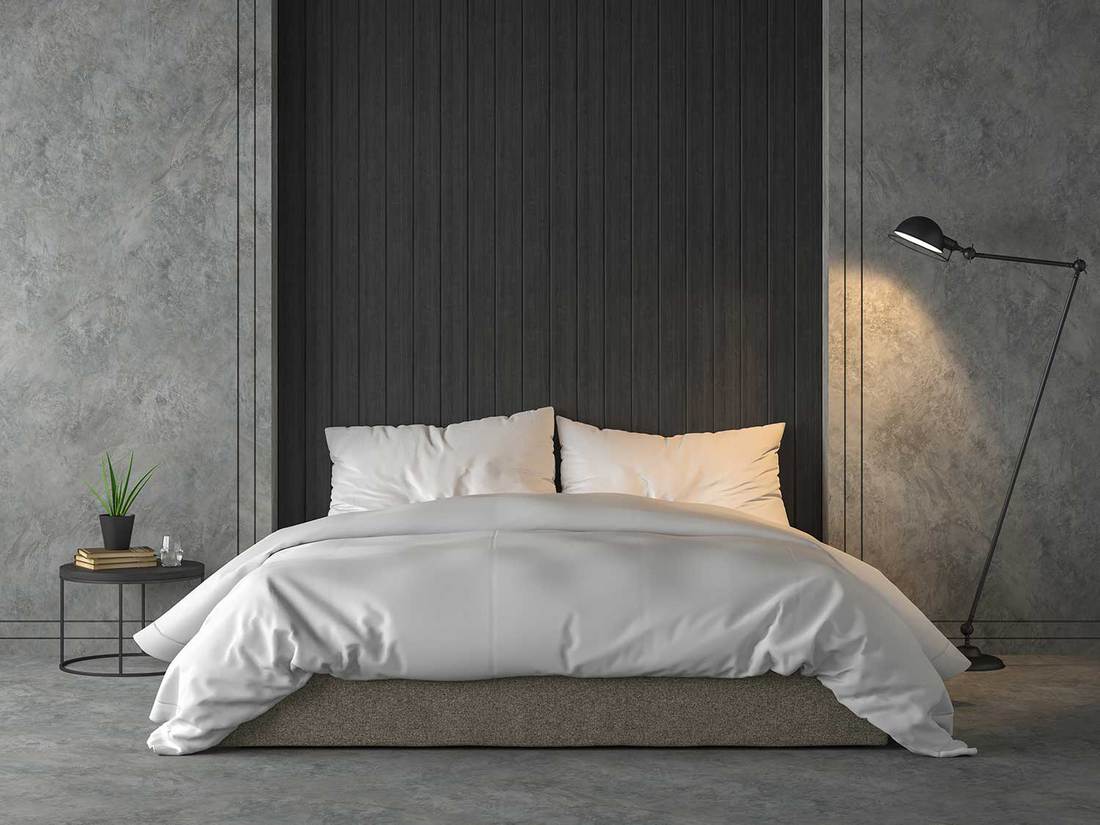
Industrialist design is extremely flexible, making it a great way to combine different themes. For example? Minimalism and industrialism work together very well!
6. Bare Minimum

Industrialism can be accomplished completely through the use of color. Neutral and natural colors, like the ones that would be found in concrete, steel, and wood, are easy colors to find and make for a simple way to create a theme with any of your surroundings.
7. Common Colors

A careful selection of warmer bricks and wood can take what is normally a colder theme of decorating, and make it much more welcoming and personable.
8. Whitewash

Flowers are a great way to add a pop of color to a theme that can naturally be a little dreary, due to its penchant for neutral shades.
9. Themes on Themes

You may have chosen industrial design as your central theme, but that doesn't mean you can't personalize it further! Take something you love, whether it be bikes, plants, geology, or even shoes, and make what you love something special.
10. Unique Interior
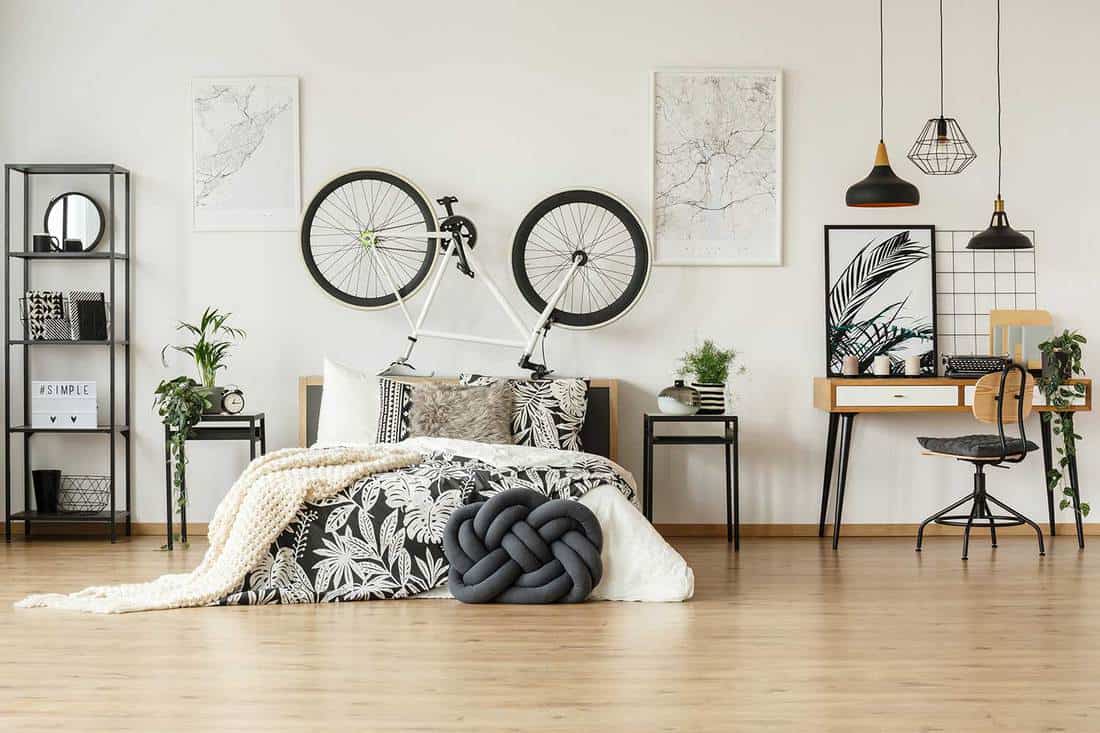
Industrialism isn't just about the wood, concrete, exposed wiring, and other things. It also incorporates unexpected elements. This means that hanging a bike on the wall is something that you can get away with!
11. A Modern Flair

Industrial doesn't have to mean old! The metal shelves towards the side, the use of the color grey throughout, and the wood ceiling do a fantastic job of putting together an industrial aesthetic while keeping it modern.
12. Fashion and Function

One of the things that make industrial design what it is is the mixture of fashion and function. Open spaces mean room for the things you need, and the ability to decorate, but it also means room for storing things you need, often without the need to hide them.
13. Exposure
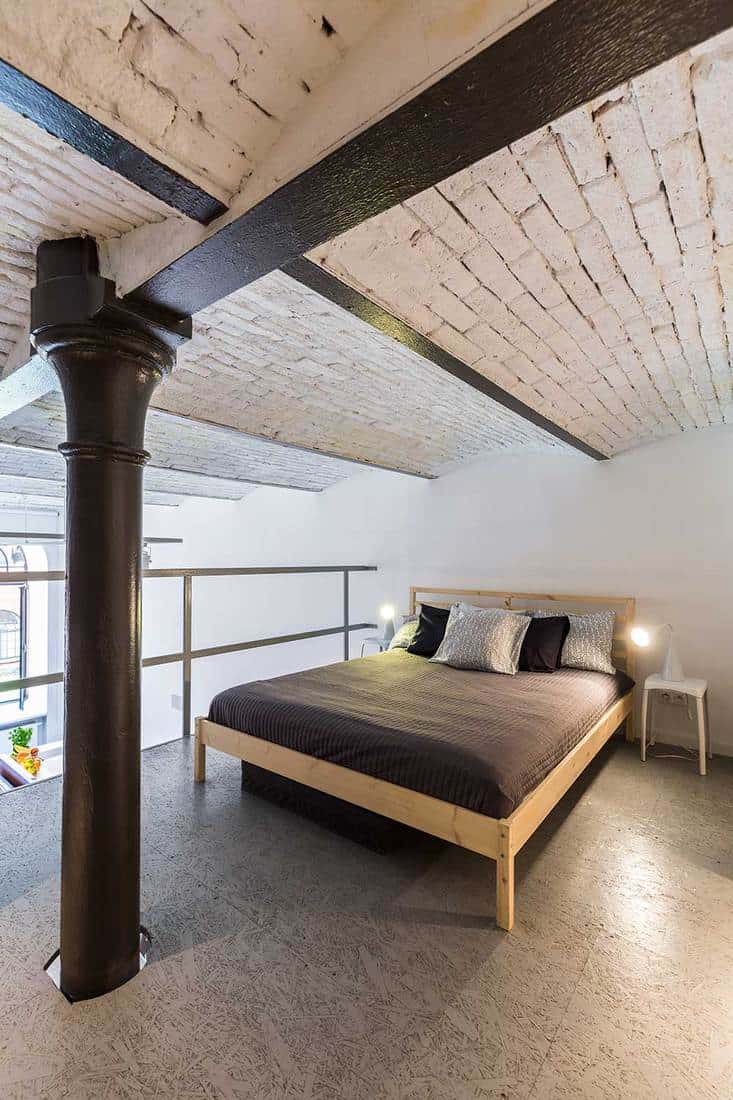
Painted particleboard, an exposed pipe coming through the floor, and a brick ceiling? This couldn't be anything but industrial!
14. Contrast

Industrial design draws its inspiration from the stark exposure of many empty spaces originally used for manufacturing. That start contrast can be captured by using contrasting colors, as well as neutral tones when decorating.
15. Metallics

While they most certainly aren't a requirement, metallic colors and objects are a great way to build towards an industrial feel, especially since they can be included in things not traditionally made of metal, like blankets, and pillowcases.
16. Coats of Paint
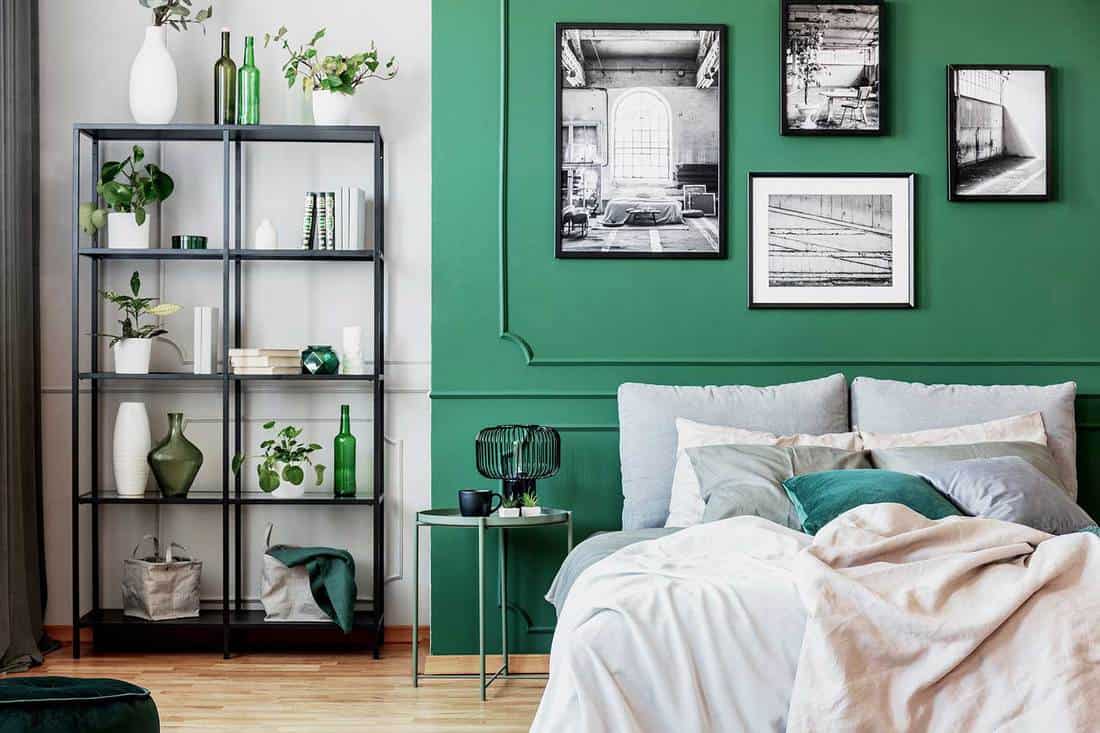
While you may not see many examples of industrialism with new paint involved, that doesn't mean it can't be done! Base elements of wood and metal can be included to keep the industrial feel, and you can use paint or bedding to get the colors you want in the room.
17. Rustic

Industrial design is the go-to for reclaiming old spaces. While it isn't a requirement to have such a space to decorate with industrial inspiration, there's something special about taking a cold, space, and giving it the comfort of home.
18. Find Your Vibe
This design is a perfect example of what you can do when you decide to take a theme and make it your own. The appearance of exposed brick hinted at occasionally on the walls, bedding that matches the wood, and a few cacti make a gorgeous bedroom!
19. A Clear Focus

When you use minimal amounts of color in your design scheme, it's easy to create a clear focus and draw attention to what you want. A space theme, with its blacks and whites, is a great way to accomplish that!
20. Run With It

Industrial design is an incredibly fun theme when it comes to decor because it's one of those "anything goes" styles. If it's unique, go for it, part of industrialism involves including elements that don't seem to fit.
21. The Bigger Picture
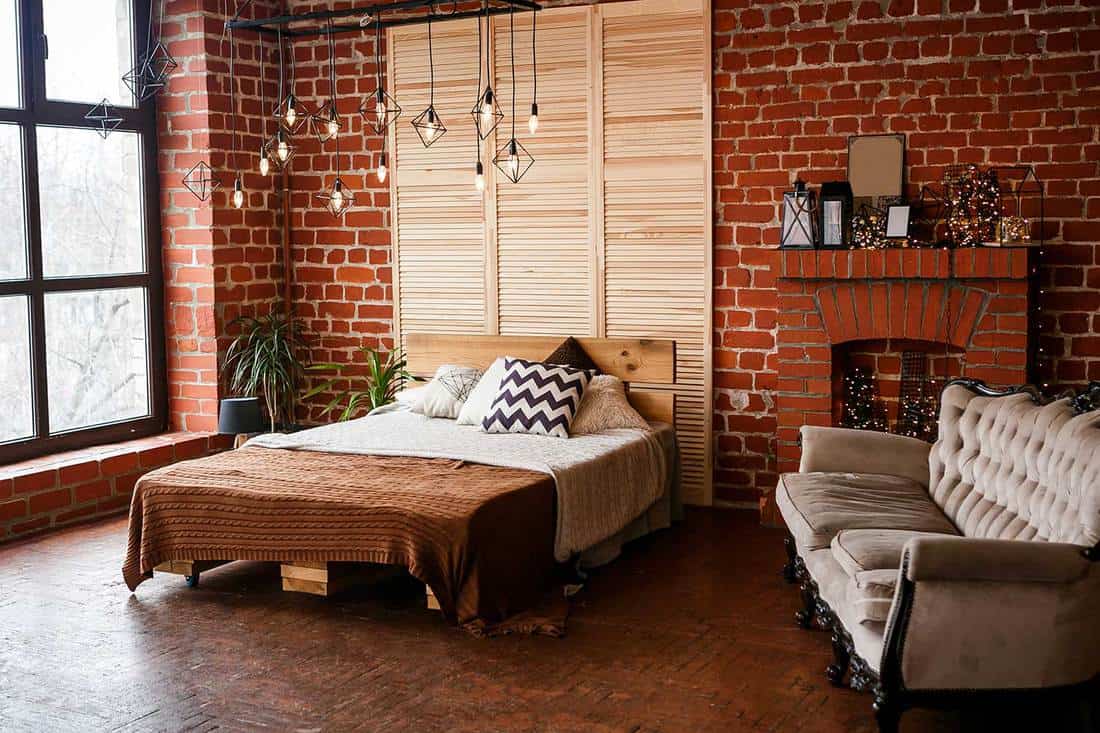
An expanded view of the previous picture, we get to seem more of the details that make this room special. The balance of antique and modern extends from the fixtures to the furniture, giving a very timeless feeling.
22. Expect the Unexpected
Make sure to leave room for surprises! For example, the wicker lamp on the ground. The wicker doesn't match anything else, and the floor is an odd place to keep it, but part of industrial design is making sure you have a personal touch.
23. Checkers
A great way to coordinate your room is to buy bedding that collaborates with the colors of your walls, ceiling, and carpet. You won't have to worry about color clashing, a room that seems too busy, and it will make it a lot easier to choose bedding.
24. Light and Dark
Industrial spaces generally have a high light exposure, which many people like, but some don't. If you like the space, but not the light, find some curtains that coordinate with the brick or wood used in the room!
25. Too Many To Choose
Brick, so common in industrial design, can make you shy away from the whole concept if you aren't a fan of the natural red it generally comes in. You can still use the brick, paint it in a color that suits your fancy!
26. All or Nothing?
You don't have to have a room completely devoted to industrial style. If there are just certain elements you like, you can incorporate just those. For example, a wall that appears only partially to be made of concrete.
27. Accents
Accent colors can make a world of difference. Take a green comforter, add a few houseplants, and you have a complete aesthetic perfectly tailored to your preferences.
28. Imposter?
You can often incorporate other items of decor to replace aspects of industrial design you don't like. For example. you can use brown or red curtains, as this person did, as an alternative to using brick.
29. Wires and Bars
When it comes to industrially themed bedrooms, you can't go wrong with exposed light fixtures, and metal fixtures or decor, like the clock hanging on the wall.
30. A More Modern Age
Add something modern to the room to make it stick out! A light fixture, dresser, or painting are all great additions.
31.Transparency
This design utilizes glass to great effect. When dealing with internal balconies where a wall is needed, barriers of glass, wood, metal, and brick can be implemented.
32. Age and Class
Pillows are a great way to add your flair to any space, whether it be your bed or the couch. Don't be afraid to play around to find your style!
33. Wall Art
If paintings aren't your style, you can add paint directly to the wall! Using a variety of tools, you can have a mural right in your own home.
34. It's All In the Framework
This bed frame made out of piping is a perfect example of a piece of furniture that adds the perfect industrial ambiance to your bedroom.
35. Shapes and Sizes
Low, squat furniture does a fantastic job of filling space and helping a room seem wider than it is. It's especially helpful in bigger places where you use furniture to establish boundaries.
36. Lights
Hanging lights are a wonderfully simple way to achieve the desired effect when it comes to industrial design. With expose comes a sense of vulnerability, which is the aesthetic you're looking for.
37. Think Brick!
You don't need to choose just one kind of stereotypically industrial type of decor. For example, these walls use more than one type of brick, and it gets pulled off beautifully.
38. Facade
If you live in a subdivision house but want the concrete wall look, you can use wallpaper! If that seems too daunting, you can also shoot for simple grey walls, but it won't have the same effect.
39. Hard Lines
Industrial design, by nature, can feel harsh due to the frequent use of metal, stone, and wood. Adding decor with soft edges, like thick blankets and items with round corners, can help!
40. Sensical
While an unutilized exposed metal bedframe might not make logical sense to include as part of your bedroom, when it comes to decorating, not everything has to serve a specific function. If you like the way it looks, then go for it!
41. The Old and the New
While industrialism generally does include some older items or installments, that doesn't mean you have to have a place that looks old. You can take an older place, and add new decor, along with a modern floorplan to spice things up.
42. Blue Steel
Since the walls, ceiling, and floors are most commonly neutral tones, industrial design generally relies on the use of furniture to bring your personal touch to the room, and to add any color you may want to include.
43. Light
Having exposed lights doesn't mean that they always need to be bare bulbs hanging from the ceiling. If you want to add more light more industrially, many different kinds of lamps and stands will fit this decor style perfectly.
44. Central Space
Industrial spaces are often great places to look if you need lots of space. For example, this room is big enough to have a central bed, surrounded by a computer desk and bookshelves.
45. Age
The aged brick wall in the background gives a perfect ambiance to this room, bringing the dark colors from the bedding and the nightstand farther up the wall and drawing attention to the black metal doors.
46. Choices
This design was taken a step further with the inclusion of an extra raw element. The rocks surrounding the bed certainly aren't common, but it brings the white of the walls and ceiling to the floor, helping everything blend beautifully.
47. Red Brick Wall
The inclusion of interior brick is a great way to improve on an industrial decor theme. Why? Any hint of exposure, specifically of things that are generally covered up, gears our minds to think of classic industrialism.
48. Organizing Space
Some of the classically "industrial" spaces are lofts and studios, places that are generally very open. In places like this, the furniture you choose divides up the given space, rather than physical walls.
49. High Light
High windows let in lots of light, and thanks to the addition of neutral colors, the combination of the two opens the space up, making it seem bigger than it is.
50.
This could be any bedroom in so many common subdivision houses. What qualifies it as industrial? Neutral colors and a wall that appears to resemble aged, scored concrete, easily replicated with wallpaper.
51. Vulnerability
You don't have to own an industrial space to decorate industrially. Like all art, you can use it as an inspiration to fill in space. This example uses exposed wood and wire to a simple yet effective end.
![51-Industrial-Bedroom-Ideas-[Picture-Inspiration-and-Tips]](https://homedecorbliss.com/wp-content/uploads/2019/12/51-Industrial-Bedroom-Ideas-Picture-Inspiration-and-Tips1-pin2.jpg)
Source: https://homedecorbliss.com/industrial-bedrooms/
